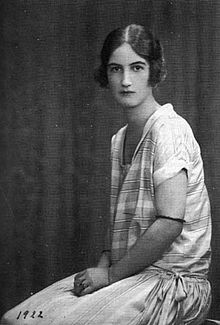Nina Georgievna Romanova

Nina Georgievna Romanova (Russian Нина Георгиевна Романова * June 7 jul. / June 20 greg. 1901 in the Mikhailovsky Palace in Saint Petersburg , † 27 February 1974 in Wellfleet , Massachusetts ) was a member of the House of Romanov-Holstein-Gottorp .
Life
Childhood and youth
Nina was the first of two daughters of Grand Duke Georgi Michailowitsch Romanow (1863-1919) and his wife Princess Maria of Greece and Denmark (1876-1940). On her father's side, she was the granddaughter of Grand Duke Mikhail Nikolajewitsch Romanow , the youngest son of Tsar Nicholas I of Russia , and Princess Cäcilie von Baden . King George I of Greece and Grand Duchess Olga Konstantinovna Romanova were her maternal grandparents. Her sister Xenija Georgievna was born on August 22, 1903.
Nina and her sister spent the first years of their lives in the Mikhail Palace in Saint Petersburg, the residence of their grandfather Mikhail Nikolayevich Romanov. In 1905 the family moved to a newly built smaller palace in the Crimea . The palace, built in the English style, was given the Greek name "Harax". The family lived a very quiet life. Sometimes when Nina and Xenija were in Saint Petersburg, they played with the Grand Duchesses Maria and Anastasia , the youngest daughters of Tsar Nicholas II.
The marriage of Nina's parents was considered unhappy. Georgi was a devoted father and the two daughters had a close relationship with him. Maria, on the other hand, never felt completely at home in Russia and preferred to stay abroad, for example in Greece and Great Britain . Over time, the couple became more and more estranged from each other. In 1914 Maria traveled to Great Britain with her children, under the pretext of benefiting their health. In truth, she wanted to get away from her husband. When the First World War broke out that same year , she did not want to return to Russia. Instead, she stayed in the UK with Nina and Xenija. Nina's father, who served as a general in the Russian army , stayed in Russia. She suffered from the separation from her father and eventually never saw him again.
Nina and her family moved to Harrogate , North Yorkshire . While they were safely living in Britain, the revolution broke out in Russia. After the October Revolution , the Romanovs' assets were confiscated and Georgi and three other family members were shot by the Bolsheviks on January 30, 1919 in the Petersburg Peter and Paul Fortress . Nina later reproached Maria for not being able to see her father again.
Marriage and adult life
On September 3, 1922 Nina married Prince Paul (georg .: Pawle) Alexandrowitsch Tschawtschawadze (1899–1971) in London . He came from the noble Chavchavadze family from the Kakheti region in Georgia . He was also a descendant of the last Georgian King George XII. Nina had already met him at the age of seven at a party in the British embassy in Rome . Paul's family had also lost many possessions during the revolution. His father had been murdered by the Bolsheviks. On May 20, 1924, their only child, David (Georg .: Dawit) Chavtschawadze († October 5, 2014) was born.
In 1927 the small family moved to the United States and settled in New York . In 1939 they moved to Wellfleet, Massachusetts. Nina worked as an artist, her husband worked as an author and translator. He wrote several books and translated works into English. Because of his good knowledge of Russian, her son became a CIA officer in the Soviet Union . After retiring, he specialized in the Russian nobility and wrote books on the subject. Nina's husband died in 1971. She died on February 27, 1974 at the age of 72.
Web links
- Princess Nina Georgievna: A Russian Passport
- Royal Collection Trust: Grand Duchess Maria Georgievna, Princess Nina Georgievna and Princess Xenia Georgievna 1917
Individual evidence
- ↑ a b Princess Nina Georgievna of Russia | People / Characters | LibraryThing. In: www.librarything.com. Retrieved March 28, 2016 .
| personal data | |
|---|---|
| SURNAME | Romanowa, Nina Georgievna |
| ALTERNATIVE NAMES | Романова, Нина Георгиевна (Russian) |
| BRIEF DESCRIPTION | Russian nobles, member of the House of Romanov-Holstein-Gottorp |
| DATE OF BIRTH | June 20, 1901 |
| PLACE OF BIRTH | Mikhail Palace , Saint Petersburg |
| DATE OF DEATH | February 27, 1974 |
| Place of death | Wellfleet , Massachusetts |
